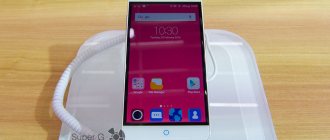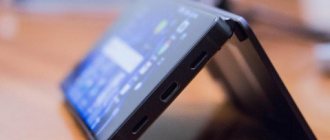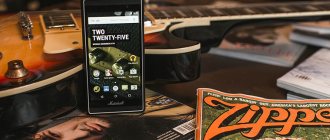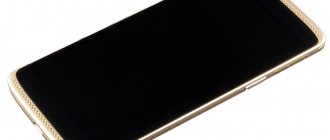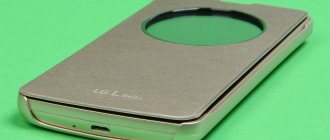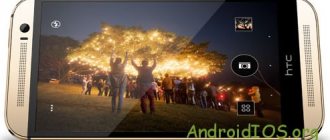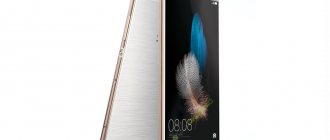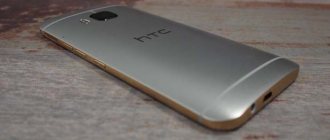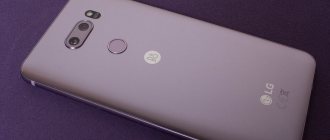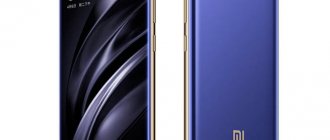Specifications
- Screen: 5.7 inches, aspect ratio 18:9, S-IPS LCD, 2160×1080 424 ppi, polarizing filter, 2.5D.
- Operating system: Android 8.1 Oreo.
- Chipset: Qualcomm Snapdragon 450 (SDM450).
- CPU: Cortex-A53 (8 x 1.8 GHz).
- GPU: Adreno 506.
- RAM: 3/4 GB.
- Built-in memory: 32/64 GB + microSD up to 256 GB.
- Main camera: dual 16 MP (f/1.8) + 5 MP, LED flash.
- Front camera: 13 MP (f/2.0).
- Battery: 3200 mAh, non-removable.
- Dimensions: 151.4 x 70.6 x 7.5 mm.
- Weight: 140 gr.
- Slots: 2 nano-SIM + microSD (combined tray).
- Communications: LTE.Cat 6, VoLTE, Bluetooth 4.2, Wi-Fi 802.11b/g/n 2.4 GHz, NFC, GPS (A-GPS), GLONASS, BDS, USB OTG.
- Sensors: light, proximity, accelerometer, gyroscope, fingerprint scanner, compass, step detector.
Review of the budget smartphone ZTE Blade V9 Vita
The budget smartphone of the Chinese brand ZTE, Blade V9 Vita, can offer a lot of things that cannot be found in ordinary “state-priced” phones. The manufacturer did not become greedy and released a mobile device with NFC, a dual camera and face unlock function at a very reasonable price.
Key Features of ZTE Blade V9 Vita
- SoC Qualcomm Snapdragon 435, 8 cores ARM Cortex-A53 @1.1/1.4 GHz
- GPU Adreno 505
- Operating system Android 8.1
- Touch display IPS 5.45″, 1440×720 (18:9), 295 ppi
- Random access memory (RAM) 2/3 GB, internal memory 16/32 GB
- MicroSD support up to 128 GB
- Nano-SIM support (2 pcs.)
- GSM/GPRS/EDGE networks (850/900/1800/1900 MHz)
- WCDMA/HSPA+ networks (850/900/2100 MHz)
- Networks LTE Cat.7 FDD Band 1, 3, 5, 7, 8, 20, 38
- GPS (A-GPS), Glonass
- Wi-Fi 802.11b/g/n (2.4 GHz)
- Bluetooth 4.2
- NFC
- Micro-USB, USB OTG
- 3.5mm audio jack
- Main camera 13 MP, f/2.0 + 2 MP, autofocus; video 1080p
- Front camera 8 MP, f/2.2, fixed. focus
- Proximity and lighting sensors, accelerometer, magnetometer
- Battery 3200 mAh
- Dimensions 147×69×7.6 mm
- Weight 135 g
| Average price of ZTE Blade V9 Vita (2/16 GB) | Average price of ZTE Blade V9 Vita (3/32 GB) |
| find out prices | find out prices |
| Retail offers ZTE Blade V9 Vita (2/16 GB) | Retail offers ZTE Blade V9 Vita (3/32 GB) |
| find out the price | find out the price |
Appearance and ease of use
The body of the ZTE Blade V9 Vita is made entirely of polycarbonate. It is monoblock (non-separable), has no metal elements or inserts. The plastic casing completely covers the back part and all ends.
The frame around the screen is quite narrow (although the huge margins above and below the screen now look unusual), the screen is small by today's standards, so the body can even be called compact. The ratio of screen area to front panel area is 77% here, while in modern “handsome” devices it can exceed 90%. But the ZTE Blade V9 Vita has a screen with a fashionable elongated geometry (with an aspect ratio of 18:9) and, fortunately, does not have a notch or rounded corners.
The plastic body has a rubberized coating that is pleasant to the touch with a soft-touch effect. The case is strong and practical. This is exactly the kind of body that a mobile device that users constantly turn in their hands should ideally have—and not at all glassy and slippery, like most expensive modern flagships.
The smartphone turned out to be small, light and even elegant; it is securely held in the hand due to the high-quality rough plastic coating, fits into any pocket, and fingerprints are completely invisible on it.
The cameras on the back almost do not protrude beyond the surface; the smartphone lies stable on the table and does not wobble when you touch the screen, since the body itself is wide and flat, without a bend in the back.
The cameras are neatly combined into a single unit and well located - they do not overlap when shooting with a finger, unlike some Samsung models, where they try so hard to do everything differently from iPhones that, contrary to logic, they embed the cameras in the center, right under the finger. The flash is very bright.
The fingerprint scanner area is easy to feel blindly; it is slightly recessed and stands out tactilely. The scanner works well.
An LED event indicator is installed above the screen, which is good news.
The side mechanical keys are not large, but they are tactilely different and have a very pleasant soft, but at the same time distinct stroke. They are placed conveniently on one side, so there are no complaints about these buttons.
But the card slot, unfortunately, is not triple: either two Nano-SIM cards are placed on the sled at the same time, or one of them is replaced with a microSD memory card.
At the top end there is a 3.5 mm audio output for headphones and an auxiliary microphone.
The bottom end, accordingly, contains only a Micro-USB connector and a conversational microphone, hidden somewhere behind the rows of holes along with the loudspeaker.
The smartphone is available in the following color options: dark blue, black, pink and mint. The manufacturer gave them beautiful names “Blue Space”, “Black Metal”, “Pink Flamingo” and “Mint Dragee”. The front panel under the glass is painted white or black. The housing is not protected from water.
Screen
The ZTE Blade V9 Vita smartphone is equipped with an IPS display covered with 2.5D glass with sloping edges. The physical dimensions of the screen are 62x124 mm with a diagonal of 5.45 inches, aspect ratio - 18:9. At the same time, the screen resolution is 1440x720 with a pixel density of about 295 ppi. The frame around the screen has a thickness of 3 mm on the sides, 12 mm on the bottom, and approximately 11 mm on the top. Multi-touch tests diagnose support for 5 simultaneous touches. There is automatic brightness adjustment.
A detailed examination using measuring instruments was carried out by the editor of the “Monitors” and “Projectors and TV” sections Alexey Kudryavtsev . Here is his expert opinion on the screen of the sample under study.
The front surface of the screen is made in the form of a glass plate with a mirror-smooth surface that is scratch-resistant. Judging by the reflection of objects, the anti-glare properties of the screen are better than those of the Google Nexus 7 (2013) screen (hereinafter simply Nexus 7). For clarity, here is a photograph in which a white surface is reflected in the switched off screens (on the left - Nexus 7, on the right - ZTE Blade V9 Vita, then they can be distinguished by size):
The screen of the ZTE Blade V9 Vita is noticeably darker (brightness according to photographs is 116 versus 119 for the Nexus 7). The ghosting of reflected objects in the ZTE Blade V9 Vita screen is very weak, this indicates that there is no air gap between the layers of the screen (more specifically, between the outer glass and the surface of the LCD matrix) (OGS - One Glass Solution type screen). Due to the smaller number of boundaries (glass/air type) with very different refractive indices, such screens look better in conditions of intense external illumination, but their repair in the case of cracked external glass is much more expensive, since the entire screen has to be replaced. The outer surface of the screen has a special oleophobic (grease-repellent) coating (better in efficiency than that of the Nexus 7), so fingerprints are removed much more easily and appear at a lower speed than with regular glass.
When manually controlling the brightness and displaying the white field in full screen, the maximum brightness value was about 360 cd/m², the minimum was 5 cd/m². The maximum brightness is low, therefore, even taking into account the excellent anti-glare properties, screen readability on a sunny day outdoors will be questionable. In complete darkness you can get a comfortable level of brightness. There is automatic brightness adjustment based on the light sensor (it is located to the right of the front speaker slot). In automatic mode, as external lighting conditions change, the screen brightness both increases and decreases. The operation of this function depends on the position of the brightness adjustment slider. If you leave everything at default (at 50% of the scale), then in complete darkness the auto-brightness function reduces the brightness to 9 cd/m² (dark), in an office illuminated by artificial light (about 550 lux) it sets it to 135 cd/m² (normal), in a very bright environment (corresponding to lighting on a clear day outdoors, but without direct sunlight - 20,000 lux or a little more), the brightness increases to 360 cd/m² (to the maximum, as needed). We were not entirely happy with the result, so we moved the slider to about 60% of the scale and got the following values: 15, 160 and 360 cd/m² (suitable result). It turns out that the auto-brightness function works adequately and allows the user to customize their work to individual requirements. At any brightness level, there is no significant backlight modulation, so there is no screen flicker.
This smartphone uses an IPS matrix. The microphotographs show a typical IPS subpixel structure:
For comparison, you can see the gallery of microphotographs of screens used in mobile technology.
The screen has good viewing angles without a significant color shift even with large deviations of the view from perpendicular to the screen and without inverting (except for the very darkest when deviating along one diagonal) shades. For comparison, here are photographs in which the same images are displayed on the screens of the ZTE Blade V9 Vita and Nexus 7, while the screen brightness is initially set to approximately 200 cd/m² over a white field in the entire screen, and the color balance on the camera is forcibly switched to 6500 K.
There is a white field perpendicular to the screens:
Note the good uniformity of brightness and color tone of the white field.
And a test picture:
The colors on the ZTE Blade V9 Vita screen have normal saturation, the color balance of the Nexus 7 and the tested screen differs.
Now at an angle of approximately 45 degrees to the plane and to the side of the screen:
It can be seen that the colors have not changed much on both screens, but on the ZTE Blade V9 Vita the brightness has decreased very much.
And a white field:
The brightness of the screens at an angle has decreased (by at least 5 times, based on the difference in shutter speed), but the screen of the ZTE Blade V9 Vita is much darker.
When deviated diagonally, the black field is lightened weakly and acquires a reddish or purple tint. The photographs below demonstrate this (the brightness of the white areas in the direction perpendicular to the plane of the screens is the same!):
And from another angle:
However, given the strong decrease in brightness at an angle, black stability cannot be considered an advantage. When viewed perpendicularly, the uniformity of the black field is average; closer to the edge, the black field becomes noticeably lighter in places:
The contrast (approximately in the center of the screen) is high - about 1100:1. The response time for the black-white-black transition is 19 ms (10 ms on + 9 ms off). The transition between halftones of gray 25% and 75% (based on the numerical value of the color) and back takes a total of 31 ms. The gamma curve, constructed using 32 points with equal intervals based on the numerical value of the shade of gray, did not reveal any blockage in either the highlights or the shadows. The exponent of the approximating power function is 2.18, which is slightly lower than the standard value of 2.2. In this case, the real gamma curve deviates slightly from the power-law dependence:
This device has a dynamic adjustment of the backlight brightness with a non-obvious dependence on time and on the nature of the displayed image. As a result, the resulting dependence of brightness on hue (gamma curve) may not correspond to the gamma curve of a static image, since the measurements were carried out with sequential display of shades of gray on almost the entire screen. For this reason, we carried out a number of tests - determining contrast and response time, comparing black illumination at angles - (however, as always) when displaying special templates with a constant average brightness, and not monochromatic fields in the entire screen. In general, such non-disabled brightness correction does nothing but harm, since constantly changing the screen brightness can at least cause some discomfort.
Color gamut is close to sRGB:
The spectra show that the matrix filters moderately mix the components with each other:
In the settings you can reduce the intensity of the blue component:
In principle, bright light can lead to disruption of the circadian rhythm (see the article about the iPad Pro with a 9.7-inch display), but everything can be solved by adjusting the brightness to a comfortable level, and there is absolutely no way to distort the color balance, reducing the contribution of blue sense.
The balance of shades on the scale is a compromise, since the color temperature is higher than the standard 6500 K, but the deviation from the blackbody spectrum (ΔE) is below 10, which is considered a good indicator for a consumer device. At the same time, color temperature and ΔE change little from hue to hue - this has a positive effect on the visual assessment of color balance. (The darkest areas of the gray scale can be ignored, since color balance there is not very important, and the error in measuring color characteristics at low brightness is large.)
Let's summarize: the screen has a low maximum brightness, therefore, even taking into account the excellent anti-glare properties, it is unlikely that the device can be used outdoors on a sunny summer day without problems. In complete darkness, the brightness can be reduced to a comfortable level. It is also possible to use a mode with automatic brightness adjustment, which works adequately. The advantages of the screen include the presence of an effective oleophobic coating, the absence of an air gap in the layers of the screen and visible flicker, high contrast and a color gamut close to sRGB. Significant disadvantages include a rapid decrease in brightness when the gaze deviates from perpendicular to the screen plane. In general, taking into account the importance of characteristics specifically for this class of devices, the screen quality can be considered average.
Camera
The front camera of the ZTE Blade V9 Vita has an 8 megapixel sensor resolution and a lens with an f/2.2 aperture, but does not have autofocus and its own flash. But stickers, portrait mode and beautifiers are not forgotten.
The shooting quality is average: the image is most often whitish, the detail is low, and there are also certain problems with sharpness across the frame.
The rear camera uses a dual module, the main camera has a resolution of 13 megapixels and a lens with an f/2.0 aperture. An auxiliary 2-megapixel module is used to create a background blur effect (bokeh). You can also change the focus point on an already taken image. The camera is equipped with fast phase detection autofocus PDAF 2.0.
There are several special modes: manual, retouching, monochrome; There's even a built-in collage option. The settings menu is clear and intuitive: you can turn off the shutter sound, display a grid, level and even a histogram, and there is a flicker suppression function. Auto HDR mode is supported. Images cannot be saved in RAW as usual.
Examples of shooting with the main camera:
In good lighting, the camera is capable of providing a pretty decent picture, with more or less decent detail, bright colors, and adequate sharpness across the entire field of the frame. Unfortunately, at the slightest deterioration in shooting conditions, the noise reduction completely eats up the details, and the emphasized contour sharpness does not help, and there is no need to talk about night photography at all. In general, this is a completely typical budget camera, you can take a successful photo with it, but for this to happen many different factors must coincide, and usually the result is quite sad.
The camera shoots video with a maximum resolution of 1080p@30 fps, using the H.264 video codec and AAC audio. There is no stabilization, handheld shooting is not smooth. The picture is average in terms of detail, sharpness and richness of colors. The camera is not at all good at night photography, especially handheld. The recorded sound has a gurgling echo effect.
Video examples:
- Video No. 1 (27 MB, 1920× [email protected] fps, H.264, AAC)
- Video No. 2 (52 MB, 1920× [email protected] fps, H.264, AAC)
- Video No. 3 (45 MB, 1920× [email protected] fps, H.264, AAC)
- Video No. 4 (46 MB, 1920× [email protected] fps, H.264, AAC)
- Video No. 5 (46 MB, 1920× [email protected] fps, H.264, AAC)
- Video No. 6 (39 MB, 1920× [email protected] fps, H.264, AAC)
Telephone and communications
The X9 LTE modem, included in the Qualcomm Snapdragon 435 SoC, theoretically supports LTE Cat.7/13 networks with data transfer rates of up to 300/100 Mbps. However, on the ZTE corporate website only support for LTE Cat.4 (150/50 Mbit/s) is indicated. In any case, all three LTE FDD bands used in Russia are supported (Band 3, 7, 20), which is much more important. In practice, within the city limits of the Moscow region, the device demonstrates quite reliable operation in fourth-generation wireless networks.
It’s also nice that such an inexpensive smartphone has NFC support, but they saved on supporting the second Wi-Fi band (5 GHz).
The navigation module works with GPS (with A-GPS) and with the domestic Glonass, and the program also detected satellites of the Chinese Beidou, although its support is not listed in the specifications. The first satellites, even during a cold start, are detected quite quickly, within the first minute, and the positioning accuracy does not cause any complaints.
The phone application supports Smart Dial, that is, while dialing a phone number, a search is immediately carried out by the first letters in contacts. Methods for setting up sorting and display of contacts are standard for the Android interface. The vibration alert is very weak.
The smartphone supports both SIM cards in 4G/3G mode simultaneously in active standby mode. The SIM card will standby on 3G voice even if another card is assigned to 4G data. The cards operate in Dual SIM Dual Standby mode, there is only one radio modem.
Software and multimedia
As a software platform, ZTE Blade V9 Vita uses Android OS version 8.1 with the ability to update over the air (OTA). The interface is clean, without its own shell, only a few functions have been added and expanded. For example, it is possible to swap buttons in the navigation bar, display a virtual smart button, and enable support for simple gestures such as lifting and turning the body over.
It is worth noting support for face unlock. This function does not work particularly quickly; in the dark, the face is poorly recognized.
To play music, the ZTE Blade V9 Vita uses the standard Google Music player with a five-band equalizer and a set of manual settings. Through the speaker, the smartphone sounds very simple, and in the headphones the sound is monotonous, without the obvious presence of low frequencies and bass, not very clear, and the volume reserve is clearly not enough for a noisy environment. There is FM radio. The recorder does not demonstrate very high sensitivity.
Performance
ZTE Blade V9 Vita runs on the Qualcomm Snapdragon 435 hardware platform, manufactured using a 28-nanometer process technology. This SoC is configured with eight Cortex-A53 processor cores in two clusters with frequencies up to 1.1 and up to 1.4 GHz. Adreno 505 is used as a video accelerator. The amount of RAM is 2 or 3 GB, the storage capacity is 16 or 32 GB.
It is possible to connect memory cards, and application files can be transferred to the card, thus freeing up space on the internal storage. Connecting flash drives in USB OTG mode is also supported.
Qualcomm Snapdragon 435 is a budget-level platform, the solution is far from the most powerful and not the fastest, but the GPU supports the Vulkan API and Open GL ES 3.1, and the smartphone scores about 60K points in AnTuTu. It is intended for entry-level mobile devices and so far copes with the main tasks of such solutions. As for games, most of them, surprisingly, do not experience problems; even Injustice 2 does not slow down, although it is noticeable that games are running at the lowest settings.
Testing in comprehensive tests AnTuTu and GeekBench:
For convenience, we have compiled all the results we obtained when testing the smartphone in the latest versions of popular benchmarks into tables. The table usually adds several other devices from different segments, also tested on similar latest versions of benchmarks (this is done only for a visual assessment of the obtained dry figures). Unfortunately, within the framework of one comparison it is impossible to present the results from different versions of benchmarks, so many worthy and relevant models remain “behind the scenes” - due to the fact that they once passed the “obstacle course” on previous versions of test programs.
| ZTE Blade V9 Vita (Qualcomm Snapdragon 435) | TP-Link Neffos X9 (MediaTek MT6750) | Samsung J6 (Samsung Exynos 7870) | Tecno Pouvoir 2 (MediaTek MT6739WA) | Xiaomi Redmi 6A (Mediatek Helio A22) | |
| AnTuTu (v7.x) (bigger is better) | 59747 | 55182 | 62893 | 37910 | 62240 |
| GeekBench (v4.x) (bigger is better) | 682/2595 | 645/2586 | 695/3354 | 549/1425 | 827/2456 |
Testing the graphics subsystem in gaming tests 3DMark, GFXBenchmark and Bonsai Benchmark:
When testing in 3DMark, the most powerful smartphones now have the ability to run the application in Unlimited mode, where the rendering resolution is fixed at 720p and VSync is disabled (which can cause the speed to rise above 60 fps).
| ZTE Blade V9 Vita (Qualcomm Snapdragon 435) | TP-Link Neffos X9 (MediaTek MT6750) | Samsung J6 (Samsung Exynos 7870) | Tecno Pouvoir 2 (MediaTek MT6739WA) | Xiaomi Redmi 6A (Mediatek Helio A22) | |
| 3DMark Sling Shot OpenGL ES 3.1 (bigger is better) | 326 | 98 | 254 | 91 | 281 |
| 3DMark Sling Shot Vulkan (bigger is better) | 311 | — | 311 | — | — |
| GFXBenchmark Manhattan ES 3.1 (Onscreen, fps) | 11 | 8 | 7 | 3 | 8 |
| GFXBenchmark Manhattan ES 3.1 (1080p Offscreen, fps) | 5 | 4 | 3 | 1 | 4 |
| GFXBenchmark T-Rex (Onscreen, fps) | 27 | 19 | 16 | 8 | 20 |
| GFXBenchmark T-Rex (1080p Offscreen, fps) | 17 | 13 | 10 | 5 | 13 |
Browser cross-platform tests:
As for benchmarks for assessing the speed of the javascript engine, you should always make allowance for the fact that their results significantly depend on the browser in which they are launched, so the comparison can only be truly correct on the same OS and browsers, and this is possible during testing not always. For Android OS, we always try to use Google Chrome.
| ZTE Blade V9 Vita (Qualcomm Snapdragon 435) | TP-Link Neffos X9 (MediaTek MT6750) | Samsung J6 (Samsung Exynos 7870) | Tecno Pouvoir 2 (MediaTek MT6739WA) | Xiaomi Redmi 6A (Mediatek Helio A22) | |
| Mozilla Kraken (ms, less is better) | 13399 | 15128 | 11974 | 18904 | 11431 |
| Google Octane 2 (bigger is better) | 3266 | 2998 | 3818 | 2617 | 4290 |
| JetStream (bigger is better) | 17 | 17 | 13 | 24 |
AndroBench memory speed test results:
Heat
Below is a thermal image of the rear surface obtained after 15 minutes of fighting with a gorilla in the game Injustice 2 (this test is also used to determine autonomy in 3D games):
Heating is localized in the upper part of the device closer to the right edge, which apparently corresponds to the location of the SoC chip. According to the heat chamber, the maximum heating was 53 degrees (at an ambient temperature of 24 degrees), this is very strong heating.
Playing video
To test the omnivorous nature of video playback (including support for various codecs, containers and special features, such as subtitles), we used the most common formats, which make up the bulk of the content available on the Internet. Note that for mobile devices it is important to have support for hardware video decoding at the chip level, since it is most often impossible to process modern options using processor cores alone. Also, you shouldn’t expect a mobile device to decode everything, since the leadership in flexibility belongs to the PC, and no one is going to challenge it. All results are summarized in a table.
| Format | Container, video, sound | MX Video Player | Standard player |
| 1080p H.264 | MKV, H.264, 1920×1080, 24 fps, AAC | plays normally | plays normally |
| 1080p H.264 | MKV, H.264, 1920×1080, 24 fps, AC3 | plays normally | no sound |
| 1080p H.265 | MKV, H.265, 1920×1080, 24 fps, AAC | plays normally | plays normally |
| 1080p H.265 | MKV, H.265, 1920×1080, 24 fps, AC3 | plays normally | no sound |
Further testing of video playback was performed by Alexey Kudryavtsev .
We did not find the MHL interface, like Mobility DisplayPort, in this smartphone, so we had to limit ourselves to testing the output of video files on the screen of the device itself. To do this, we used a set of test files with an arrow and a rectangle moving one division per frame (see “Method for testing video playback and display devices. Version 1 (for mobile devices)”). Screenshots with a shutter speed of 1 s helped determine the nature of the output of frames of video files with various parameters: the resolution varied (1280 by 720 (720p), 1920 by 1080 (1080p) and 3840 by 2160 (4K) pixels) and frame rate (24, 25, 30, 50 and 60 fps). In the tests we used the MX Player video player in the “Hardware” mode. The test results are summarized in a table (the smartphone does not play 4K files):
| File | Uniformity | Passes |
| 1080/60p | cannot be played | |
| 1080/50p | cannot be played | |
| 1080/30p | Great | No |
| 1080/25p | Great | No |
| 1080/24p | Great | No |
| 720/60p | Great | No |
| 720/50p | Fine | No |
| 720/30p | Great | No |
| 720/25p | Great | No |
| 720/24p | Great | No |
Note: If both columns Uniformity and Skips have green ratings, this means that, most likely, when watching films, artifacts caused by uneven alternation and skipping of frames will either not be visible at all, or their number and visibility will not affect comfort viewing. Red marks indicate possible problems with playback of the corresponding files.
According to the frame output criterion, the quality of playback of video files on the screen of the smartphone itself is good, since in most cases frames (or groups of frames) can (but are not required) be output with more or less uniform alternation of intervals and without skipping frames. When playing video files with a resolution of 1280 by 720 pixels (720p), the image of the video file itself is displayed one-to-one pixel by pixel, exactly at the height of the screen (in landscape orientation). The brightness range displayed on the screen corresponds to the standard range of 16-235: all shade gradations are displayed in shadows and highlights, which is required for correct playback of typical video files. Note that this smartphone does not support hardware decoding of H.265 files with a color depth of 10 bits per color.
Battery life
The ZTE Blade V9 Vita battery has a capacity of 3200 mAh, and the smartphone demonstrates quite decent battery life results - obviously, the presence of a Qualcomm hardware platform with good optimization affects it.
In real-life conditions of use under normal, average operating conditions, the hero of the review confidently survives until the evening charge, and can last up to two days with an economical approach.
Testing has traditionally been carried out at the usual level of power consumption without using power saving functions, although the device has them.
| Battery capacity | Reading mode | Video mode | 3D Game Mode | |
| ZTE Blade V9 Vita | 3200 mAh | 16:00 | 9:00 a.m. | 4 hours 50 minutes |
| TP-Link Neffos X9 | 3060 mAh | 11:00 am | 6:30 a.m. | 3:00 am |
| Samsung Galaxy J6 | 3000 mAh | 16:20 | 13:00 | 7:00 am |
| Xiaomi Redmi 6A | 3000 mAh | 19:00 | 13:00 | 6 hours 40 minutes |
Continuous reading in the FBReader program (with a standard, light theme) at a minimum comfortable brightness level (brightness was set to 100 cd/m²) lasted 16 hours until the battery was completely discharged, and when continuously watching videos in high quality (720p) at the same level brightness via a home Wi-Fi network, the device operates for 9 hours. In 3D gaming mode, the smartphone can work for up to 5 hours, depending on the specific game.
There is no fast charging here; from a regular network adapter (2 A 5 V), the smartphone is fully charged within 2.5 hours with a current of 1.5 A at a voltage of 5 V. Wireless charging is not supported.
Bottom line
In official Russian retail there are two modifications of the ZTE Blade V9 Vita: with 2 GB of RAM and 16 GB of ROM for 10 thousand rubles, and only a thousand more expensive - with 3/32 GB. A smartphone with a fashionable screen geometry, an extremely pleasant thin, relatively compact and practical body, on a fast Qualcomm platform for a budget level, and even with NFC - this is practically a gift.
By the way, there is also an older model Blade V9 (not Vita) - it has more memory, a more powerful platform (Qualcomm Snapdragon 450), a larger display, higher resolution, higher-class cameras, but it also costs around 14 thousand. In general, among the Blade V9 models, ZTE has something to choose from, as they say, for any budget.
Appearance
ZTE Blade V9 continues the parade of glass smartphones with elongated displays. The device body is built on an aluminum frame of an unusual trapezoidal shape. The color scheme does not stand out from modern fashion: black, gold and blue.
The front panel is decorated with a display with an aspect ratio of 18:9. Above it: the front camera, sensors, LED indicator and earpiece. Oleophobic coating helps keep your smartphone clean. The frames around the display are moderately thin and do not catch the eye. In general, the front panel gives a feeling of lightness; nothing distracts from reading information from the display.
At first glance, there is nothing unusual in the back panel - the usual glass. But as soon as the light hits it, the panel is filled with original shimmers and stripes. The effect is achieved through photoengraving technology, something similar we have already seen in Honor 9. The olephobic back is quite effective, stains and fingerprints are wiped off easily.
The layout of the elements repeats the ARCHOS Diaomond Omega, also known as the ZTE Nubia Z17S. The dual camera unit with flash is shifted to the left, a fingerprint scanner and a manufacturer's label. The protruding glass of the cameras is not protected by a side - the decision is extremely controversial.
The fingerprint scanner works in 9 cases out of 10, it all depends on the accuracy of application. Scanning speed lags behind flagships - fast, but not lightning fast.
As already noted, the smartphone is built on an aluminum alloy frame; ZTE engineers did not bother with plastic inserts for connecting connectors. All technological holes are carefully made in the metal. At the bottom end there is a main microphone, microUSB for charging and a multimedia speaker. The microUSB port in a far from budget device is perceived as archaic. On top is an additional microphone and a 3.5 mm port for connecting a wired headset.
On the left side there is a combined tray for two nano SIM, or nano SIM + microSD. The tray is made of plastic and coated with metallic paint.
On the right is the power key and volume rocker. The power button is highlighted with a rough texture.
At first glance, the ZTE Blade V9 is the same as all modern smartphones. Although it is glass, it lies securely in the hand. But it tries to slip away from a smooth surface. A large display with a relatively small width of the device is the same as everyone else’s. However, small stylistic features such as the original shape of the side frame and the iridescent back panel catch the eye. As a result, the smartphone does not look boring.
Screen
The V9 screen has a diagonal of 5.7 inches and a resolution of 2160x1080 pixels; there is a good oleophobic coating, thanks to which fingers glide perfectly on the glass and fingerprints are removed without the slightest effort.
The detail of the IPS matrix is good, individual pixels cannot be seen even closely, but the color rendering is a little overwhelmed with warm shades - the white color is yellowish, but not critical.
There are no color distortions when changing viewing angles. The settings include a night mode that can be configured according to a schedule.
Display
Widescreen displays are a standard for flagships, which are gradually capturing the mid-price segment. ZTE Blade V9 belongs to the middle class and is equipped with a 5.7-inch display with an aspect ratio of 18:9 and a resolution of 2160 × 1080 pixels. Matrix type - IPS. There is no information about the brand of protective glass, but the surface is excellent at resisting scratches. After a week of active testing, the glass looks like new. The oleophobic coating also did not disappoint; fingerprints are wiped off easily.
The module is completely laminated - there is no air gap between the screen, touch layer and protective glass. The solution allows you to achieve maximum viewing angles. There are no flares on the display, which are often found with IPS matrices, even the black color looks even. The light sensor works more than adequately; in everyday use there is no need to manually adjust the brightness. At the same time, the maximum level will be enough on a sunny day, but the minimum level is too big.
Night mode, a blue light filter, compensates for excessive minimum brightness. There are no correctors for white balance, saturation, contrast, or other software gadgets.
Conclusion
The ZTE Blade V9 Vita smartphone has quite a few shortcomings - mediocre sound from an external speaker, poor battery life and not the best screen resolution, but given the cost, all complaints about it immediately disappear. This is a good option for those who want to get maximum features at an affordable price.
Comments for the
Cackl e
You might be interested in:
Review of ZTE Blade l5 gray - a smartphone during the development of which the manufacturer saved on literally everything
ZTE Blade A6 is a budget phone whose main feature is autonomy
Review of the ZTE Blade X3 smartphone
Review of ZTE Blade Z10 - average among state employees
ZTE Blade V8 is a smartphone with really interesting features for its price
Cameras
ZTE Blade V9 is equipped with a dual main camera. The main module is 16 megapixels with an f/1.8 aperture, and the additional one is 5 megapixels.
During the day, the camera is characterized as a “point and shoot” camera. The phase detection autofocus system (PDAF 2.0) is actually fast and accurate. Automatic activation is available for HDR mode.
It's nice to see fairly high-aperture optics in a mid-range smartphone. The f/1.8 aperture of the main module allows you to take detailed images that are not spoiled by digital noise. However, in many situations there is not enough optical stabilization, which would allow setting a longer shutter speed. The option is not included in the class, which is why the software sets the values in favor of high ISO sensitivity and short shutter speed. In any case, once you find an approach, there will be no problems with exposure.
A tripod and PRO mode will correct the situation; in the right hands, a smartphone is capable of more. ISO sensitivity is adjustable from 100 to 1600, white balance from 200 to 8000 Kelvin. Shutter speed can be set from 1/69000 to 23.5 seconds. The photo can be saved in uncompressed RAW format.
The additional module is only 5 megapixels and its only purpose is to blur the background. Moreover, the standard camera application is equipped with two modes at once. The first - portrait is intended for photographing people and does not imply software changes in the depth of field.
The second is called blur and allows you to adjust the aperture value in the range from f/1.0 to f/8.0 and the focus point both during shooting and after through the gallery. The ZTE Blade V9 is great at taking portrait shots of people. The camera does not detect the boundaries of simpler shapes so correctly, which is surprising. All pictures with bokeh effect are saved in 8 megapixel resolution.
ZTE also has its own LIVE photo implementation. After shooting, two files are created: a picture in JPG format and a video in MP4. Moreover, a JPG file in full resolution up to 16 MP serves as a preview, and an MP4 file is an animation in a resolution of 1280x960. This bundle in the form of a LIVE photo is determined only within the pre-installed gallery.
Another interesting mode is monocolor. With its help, you can leave a single color in the image, which is determined using RGB sliders or a color standard.
The smartphone records video up to 1080P, 30 frames per second. One interesting thing is support for a resolution of 1440×720, that is, HD with an aspect ratio of 18:9. During the day, the ZTE Blade V9 copes with video recording with a bang. And in low light conditions there are drops below 30 FPS, that is, noticeable jerks and lags appear. Everything is according to the Snapdragon 450 class; problems with video encoding are a problem for low-cost platforms.
13 MP front camera with f/2.0 aperture and fixed focus.
Despite the fact that there is only one module, the camera supports portrait mode, based on software algorithms. The degree of blur is moderate, but the boundaries are determined accurately, which once again calls into question the relevance of the second module. There were also “improvers” of the face in the form of retouching.
Performance
ZTE Blade V9 is equipped with a Qualcomm Snapdragon 450 processor with an Adreno 506 graphics accelerator. This is far from the most powerful hardware that can be found in the price segment of 15-18 thousand rubles, but in everyday use of the smartphone there is no lack of performance.
The interface, browser, applications - everything works quickly and smoothly, you can also play games comfortably, but in demanding projects you will have to lower the graphics settings to a minimum. Also pleasing is the absence of heating and, as a result, throttling, even under prolonged high load.
Iron
The device’s hardware platform is Qualcomm Snapdragon 450. The main innovation is an updated technical process, 14 nm versus 28 nm for the Snapdragon 435. 8 Cortex A53 cores operate at a frequency of 1.8 GHz. There are two memory options: 3/32 GB or 4/64 GB of RAM and built-in, respectively.
In our hands was a version with 3 GB of RAM and 32 GB of internal memory. Additionally, you can install a microSD memory card up to 256 GB.
The smartphone behaves perfectly in everyday use - it works quickly and remains absolutely cool.
After an hour-long stress test with 100% processor load, the smartphone did not even reset the frequency, but continued to work at the standard 1.8 GHz. The temperature rose to 40-45 degrees. The epicenter of heating is the area under the main chamber; heat is also evenly distributed using the side frame. ZTE Blade V9 works stably and does not lose performance under load.
The new platform is comparable to the Snapdragon 625, which is renowned for its gaming performance. Owners of the ZTE Blade V9 can expect to run any 3D games on high and medium-high settings. And resistance to heat and lack of throttling allow you to play for a long time without brakes.
Bottom line
In official Russian retail, the ZTE Blade V9 Vita model with 2 GB of RAM and 16 ROM costs less than 9 thousand rubles, but for obvious reasons this is a dead-end option, because now 2 GB of RAM is very little for the Android OS.
It’s better to pay only a thousand extra and take the version with 3/32 GB. For such little money by the standards of the Russian market, a smartphone with NFC, a fingerprint scanner, a fashionably elongated 18:9 screen and both good cameras is quite a good purchase.
But in nature there is also a “full-fledged” version of the ZTE Blade V9 (our hero, in fact, is its simplified version). It costs from 14 thousand, but boasts a larger display with Full HD resolution, more advanced cameras with AI support and f/1.8 aperture, a powerful Qualcomm Snapdragon 450 hardware platform with Adreno 506 GPU, and, naturally, a large amount of memory . Here you will have to overpay more than 3 thousand, but it is clearly worth it.
Software
ZTE Blade V9 runs on the latest Android 8.1 Oreo. Although the system is not hidden under the shell, the smartphone does not belong to Android One, but the device is certified by Google. The smartphone comes pre-installed with the Z-Backup utility for transferring data from an old device. From third-party software: Avast antivirus, Superb Cleaner and AccuWeather, ZBackup - not the best selection, fortunately all software is removed by standard means.
ZTE Blade V9 also offers recommended applications during the initial setup process. Some programs are checked by default, you have to uncheck them.
The default desktop is styled like the Google launcher. Additional features include setting scrolling effects. And also a correct notification counter on icons, which is based on real application events.
The first distinctive feature of ZTE software is the additional functions of the fingerprint scanner. You can assign an application to any finger that will launch after unlocking. And using gestures on the surface of the sensor, you can take a photo, answer a call, or scroll through photos in galleries. The menu also allows you to open the notification panel or the menu of running applications.
Face unlocking is a trendy feature found on many smartphones, and the ZTE Blade V9 is no exception. The scanner is simple, based solely on a single front camera. Quick detection takes about a second, it works quite correctly, but the manufacturer claims that this method is insufficiently reliable. Full detection requires 1-2 seconds. The function works even in the dark, thanks to the automatic illumination of the face using the display. In general, with a fast fingerprint sensor, the face detector is just a nice bonus.
Other gestures are also not forgotten, for example, double tapping on the screen to wake up. To receive a call, just bring the smartphone to your ear, and to reject it, turn the display down. And this is not a complete list.
The virtual navigation bar keys can be swapped. And also add a floating navigation button.
Personal Space is a standard application for protecting applications, photos, videos and other files using an additional password. With applications everything is simple, add to the list. Then you will need to verify yourself using a password, fingerprint or face scanner in accordance with the selected interval. Protected photos, videos and files are only accessible within the storage and hidden from other applications. There is also a simple password manager inside your personal storage.
The built-in screenshot editor allows you to adjust the contents of screenshots. Long screenshots are also supported.
To adjust the sound in the headphones, DTS Sound is preinstalled. The application offers 3 presets and separate amplifiers for bass, vocals and treble. A 4-band equalizer is available for fine-tuning. The effects work in headphones and with the main speaker. In the first case, the effect cannot be called pronounced; the sound character of the speaker, on the contrary, changes noticeably. For unknown reasons, DTS Sound did not work with the Marshal Major 2 wireless headphones; it is possible that the problem lies with them.
Connection
The wireless interfaces of the new product are in perfect order! Two SIM cards operate in Dual SIM Dual Standby mode, one radio module. LTE.Cat 6, popular frequencies in Russia LTE Band 3, 7, 20, 38 in the list of supported ones. Wi-Fi only works in the 2.4 GHz band and this is a drawback given the novelty and class of the device. Bluetooth version 4.2.
For navigation, the smartphone uses three global satellite systems: GPS, GLONASS and BeiDou. Cold start is very fast, the device clings to satellites even indoors. An electronic compass helps you navigate the city.
NFC is full-fledged, including Mifare cards. There are no problems with the Google Pay payment system and Troika transport cards.
Communication and Internet
The key advantage of the ZTE Blade V9 over its competitors is the presence of NFC and support for Google Pay. All other communications are extremely standard - there is LTE cat.6, WiFi (albeit single-band and without .ac), Bluetooth 4.2 LE and fast-working GPS navigation, a cold start which takes about 3 seconds. The smartphone also supports dual SIM cards. There are no complaints about the quality of speech transmission; you and your interlocutor can hear each other perfectly.
